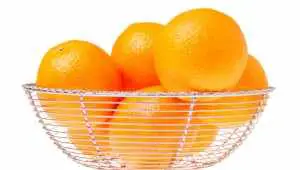Share on Social Media:
The Top 5 Orange Producing Countries
| Country | Orange Production (metric tonnes) |
% of World Production | |
|---|---|---|---|
| 1 | Brazil | 16,713,534 m/t | 22.1% |
| 2 | China | 9,103,908 m/t | 12.0% |
| 3 | India | 4,833,830 m/t | 6.4% |
| 4 | United States | 4,737,990 m/t | 6.2% |
| 5 | Mexico | 3,639,853 m/t | 4.8% |
 Special Report
Special Report
- Brazil is the world's biggest producer of oranges, producing about 1/3 of the world's production, that is, approximately 455 million boxes each weighing 40.8 Kilograms. 93.5% of the country's production is concentrated in the states of São Paulo (82.4%), Sergipe (4.7%), Bahia (3.7%) and Minas Gerais (2.7%).
- Oranges constitute the bulk of world citrus fruit production, accounting for more than half of global citrus production in 2004. World citrus production and consumption have grown strongly since the mid - 1980s. Production of oranges, tangerines, lemons and limes has expanded rapidly, and even faster growth has been realized for processed citrus products as improvements in transportation and packaging have lowered costs and improved quality. About 20 per cent of the total crop of oranges is sold as whole fruit; the remainder is used in preparing orange juice, extracts, and preserves.
- São Paulo, Brazil and Florida, the United States will continue to be the two largest processed orange producing regions in the world. With expected continued growth of clementine consumption, Spain is expected to expand its production of tangerines (mainly clementine varieties). China is also expected to expand production and consumption of oranges and tangerines. Other Latin American producing countries such as Argentina, Mexico, Cuba, Belize and Costa Rica are expected to continue to expand production, but at a slower rate. Florida produces about 70% of the total U.S. crop, and 90% of its production goes to make juice.
- World consumption of oranges grew at a compound rate of 3.5 percent over the period 1987-89 to 1997-99. Consumption of fresh oranges grew at an annual rate of 2.8 percent, while processed orange consumption grew at 4.4 percent per annum.
- Oranges are highly valued for their vitamin C content, and are a source of vitamin C for most Americans. Oranges also contain folacin, calcium, potassium, thiamin, niacin and magnesium. Most of the consumption of oranges is in the form of juice. Eating the whole fruit provides 130% of the recommended dietary allowance for vitamin C, less than the juice, but more fiber, which is not present in the juice.
- FAO corporate document repository. (2008). Retrieved Nov, 2010.
- United States Department of Agriculture. (2008). Retrieved Nov, 2010.
Tags:
Crops, China, The United States, India, South America
Sources: FAOSTAT data, 2020 (last accessed by Top 5 of Anything: December 2020).
List Notes: Orange production is in metric tonnes (m/t) for the year 2018 which is the latest year for which statistics are available (list last updated by www.top5ofanything.com Dec 2020). This top 5 list may include official, semi-official or estimated data gathered by the Food and Agriculture Organization of the United Nations.
Sources: FAOSTAT data, 2020 (last accessed by Top 5 of Anything: December 2020).
List Notes: Orange production is in metric tonnes (m/t) for the year 2018 which is the latest year for which statistics are available (list last updated by www.top5ofanything.com Dec 2020). This top 5 list may include official, semi-official or estimated data gathered by the Food and Agriculture Organization of the United Nations.

